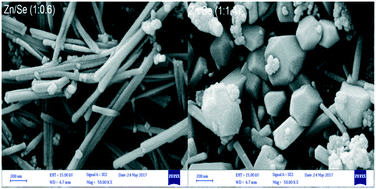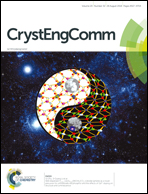Controlled morphology of ZnSe nanostructures by varying Zn/Se molar ratio: the effects of different morphologies on optical properties and photocatalytic performance
Abstract
The effects of Zn/Se molar ratio on the morphology and photocatalytic performance of ZnSe nanostructures, which were synthesized by a co-precipitation method, were investigated. To intensively investigate the effects of the Zn/Se ratio, we performed a series of controlled experiments with different concentrations of selenium anions (the concentration ratios of Zn2+ : Se2− = 1 : 0.6–1.4 in the solutions). X-ray diffraction (XRD) patterns of the samples indicated that the phases of the samples were not changed by the different Zn/Se ratios. However, the XRD patterns of the samples with a ratio of Zn/Se < 1 indicated Se peaks as an external phase. Field emission electron microscopy (FESEM) and transmission electron microscopy (TEM) images showed different morphologies such as nanoparticles (NPs), nanorods (NRs), nanobelts (NBs), and polyhedra by varying the Zn/Se ratio. In addition, a high resolution TEM (HRTEM) image of the NBs showed that the NBs grew towards the [111] direction. Photoluminescence (PL) and UV-visible spectroscopy indicated that different Zn/Se ratios caused the creation of different defects and band gap shifting. The valance band edge (VBE) position of the samples was calculated by X-ray photoelectron spectroscopy (XPS) and it was observed that, the VBE position was affected by different Zn/Se ratio and it was seen a small and big valance band offsets in comparison to the Zn/Se = 1 for the samples with highest and lowest Zn/Se ratio, respectively. Finally, the photocatalytic performance of the samples was examined under irradiation with a visible-light source. The photocatalytic activity tests demonstrated that the different morphologies and optical properties of the ZnSe nanostructures could affect the photocatalytic performance of the samples. Furthermore, N2 adsorption–desorption isotherm curves of the samples indicated two types of hysteresis loop for the samples with the highest and lowest Zn/Se ratios. It was observed that the sample with the lowest Zn/Se ratio (1 : 1.4) showed the highest photocatalytic activity and stability in comparison with the other samples.



 Please wait while we load your content...
Please wait while we load your content...